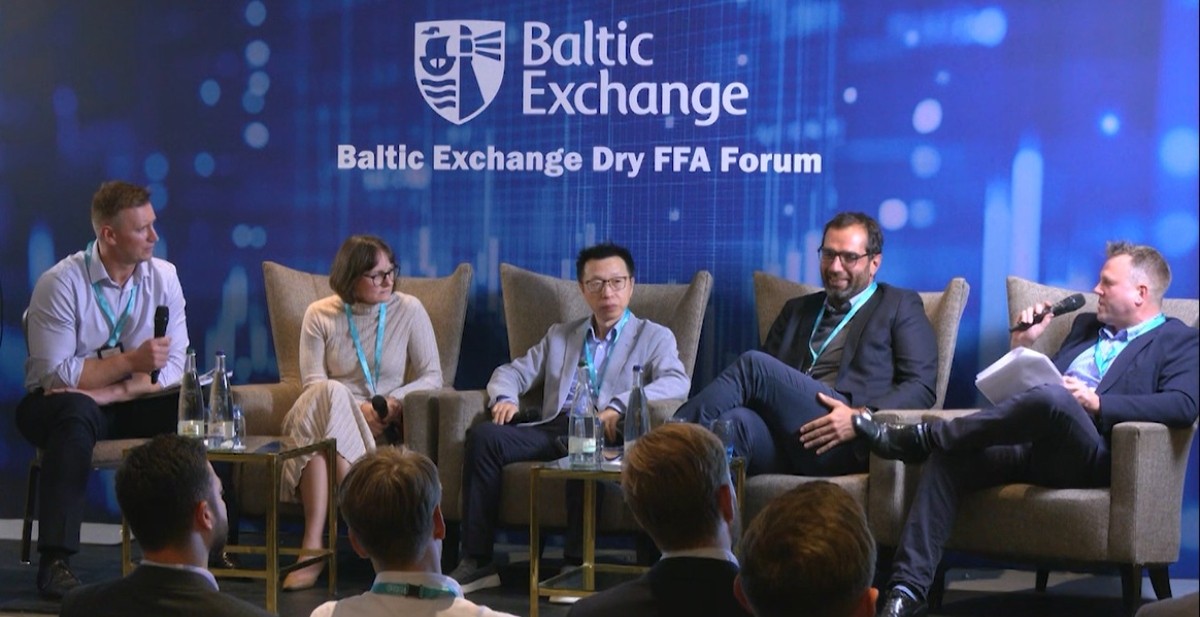Ramp up of market responsiveness

Real-time reaction to information now the norm for bulk traders
By Carly Fields
Reactivity and volatility are the new constants of the dry bulk market, driven by rapid-fire news and uncertain policy decisions, according to a recent Baltic Exchange Forum.
A panel at the Baltic’s Dry FFA Forum in Geneva, moderated by Ben Goggin, FFA assessor at the Baltic Exchange, explored how current geopolitical events, technology, and commodity market correlations are shaping both the physical and Freight Forward Agreement (FFA) markets.
A point of discussion was the market's immediate response to major global events, such as trade wars and sanctions. Goggin asked the panellists for their views on the responsiveness of the dry bulk market to seemingly daily changing discussions around tariffs and sanctions.
Ardalan Sappino, FFA trader manager at SwissMarine, noted that the dry bulk market has become “very reactive to those headlines” and that news gets digested “more and more quickly". But rapid does not imply kneejerk reactions: "I think that the market has become more and more mature to this type of headlines, reacting very rapidly.”
Nature of volatility
Goggin shifted the focus of the panel to the subsequent actions of traders, asking Karen Taylor, head of industrial commodities at ADM Investor Services, if she sees traders quickly adjusting their FFA positions in responses to news and updates. Taylor said a fundamental shift has occurred in the reliability of trade actions.
"What we used to see with a tariff or sanction was that we knew it was going to stick," she said. "Now you don't really know.”
This policy uncertainty fuels short-term chaos. "So traders are reacting," Taylor noted, "and you do get increased pockets of volatility - it's just how long that lasts really.”
Panellist Jeffrey Yao, managing director at Profision Shipping, emphasised the importance of a holistic view of the dry bulk industry being inextricably linked to the commodities it transports: "We are in the logistics business, right? This is part of the supply chain, so it is very important to understand both the upstream and downstream."
Yao highlighted the critical role of iron ore, stressing that it "is the largest commodity being shipped in dry shipping, 30-35% of the volume". This is particularly true for capesizes, where iron ore "dominates the segment". While acknowledging that "it's not the one-on-one correlation”, Yao said that industry participants "obviously look at what's happening in the iron ore market every morning" to get "some clue... [of] what's the likely impact into the shipping market". Furthermore, Yao noted that this relationship imposes natural limits, as at certain shipping rates, “it's just a demand destruction".
Scaling the FFA Market
Turning to the future growth potential of the FFA market, Goggin noted the current size of the market at $100 billion for FFAs and $90 billion for physical – “so about 1.1 times the market”.
Questioned about future growth potential of the FFA market, Neil Pearson, dry FFA broker at Lightship, expressed optimism, believing that "two to three [times] is more than possible". He also identified a key area of future growth: "I think there's a lot of interest from Indian traders at the moment”, suggesting this is "another big area where there's going to be some big growth in the market". While ambitious, he was also realistic about the timeline: "I see the potential for it to keep growing from 1.1 to two times the market, but I doubt it'll be quick. I think it'll take some time, some years.”
SwissMarine’s Sappino, however, was "a bit more sceptical on the potential of how far this market can go”, asserting that "you need some natural hedgers". When Goggin asked what could be done to encourage these, Sappino said that the educational hurdles have already been cleared, and that growth is intrinsically linked to size: "It's just the size of the market; if the market does get bigger, yes, we will have more hedging activity.”
Transparency hurdle
The challenge of attracting new participants, especially to the less traded supramax and handymax sizes, was addressed by Taylor. She framed the issue as a classic dilemma: "I think it's chicken and egg on those ones.”
New entrants, particularly commodity trading advisors and funds, "want the volume, but in order to have the volume and liquidity, they've got to be in it".
A major inhibitor is the lack of trading transparency. Funds "want transparency. So they want that screen trade," Taylor explained, but this is an environment in which “the brokers really don't want them". This, Taylor believes, is holding back growth.
In closing, the panel tackled a perennial market question: does the FFA market lead the physical market, or vice versa? Goggin framed the issue as "the tail wagging the dog". Sappino offered a diplomatic answer, suggesting it depends on perspective: "It depends on the story you want to tell, and it depends on the audience". Ultimately, he concluded, "You can see cases where that goes both ways.”